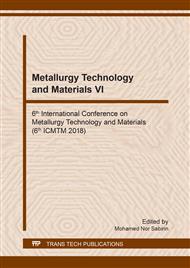p.172
p.181
p.187
p.192
p.197
p.202
p.208
p.217
p.222
Preparation of Tin Oxide Nanometer Thin Films by Hydrothermal Method
Abstract:
Given the shortage of energy reserves, new energy sources must be identified. In this regard, improving the efficiency of solar cell conversion and simplifying the solar cell technology have become the focus of research. In this study, tin oxide nanometer thin film was fabricated on FTO conductive glass as photocathode through hydrothermal method. The synthesis condition was regulated, and performance test was also conducted. Results show that the crystallization driving force, crystallization rate, and grain size of tin dioxide crystal increase with increasing alkali ratio, leading to disorganized accumulation of tin oxide. Under prolonged holding time, tin oxide crystal became complete, and the surface area of the crystal increased. The crystallization driving force and rate also increased with increasing salt concentration and accompanied by clutter of tin oxide. The optimized process condition included 1:4 molar ratio of salt to alkali, 0.05 mol/L salt concentration, 200 °C reaction temperature, and 8 days of reaction. The highest specific surface area of the tin oxide nanometer film was obtained under the optimized condition.
Info:
Periodical:
Pages:
197-201
Citation:
Online since:
August 2018
Keywords:
Price:
Сopyright:
© 2018 Trans Tech Publications Ltd. All Rights Reserved
Share:
Citation:


